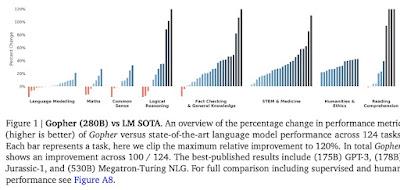Rohin Shah, [AN #173] Recent language model results from DeepMind, LessWrong, July 20, 2022.
Scaling Language Models: Methods, Analysis & Insights from Training Gopher (Jack W. Rae et al) (summarized by Rohin): This paper details the training of the Gopher family of large language models (LLMs), the biggest of which is named Gopher and has 280 billion parameters. The algorithmic details are very similar to the GPT series (AN #102): a Transformer architecture trained on next-word prediction. The models are trained on a new data distribution that still consists of text from the Internet but in different proportions (for example, book data is 27% of Gopher's training data but only 16% of GPT-3's training data). [...]
The most interesting aspect of the paper (to me) is that the entire Gopher family of models were all trained on the same number of tokens, thus allowing us to study the effect of scaling up model parameters (and thus training compute) while holding data constant. Some of the largest benefits of scale were seen in the Medicine, Science, Technology, Social Sciences, and the Humanities task categories, while scale has not much effect or even a negative effect in the Maths, Logical Reasoning, and Common Sense categories. Surprisingly, we see improved performance on TruthfulQA (AN #165) with scale, even though the TruthfulQA benchmark was designed to show worse performance with increased scale.
There's more at the link.

Chart: Gopher vs. SOTA, from the original paper, p. 9.

